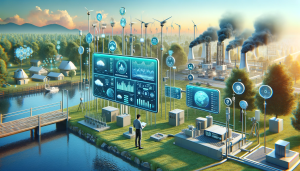 UseCasesFor.ai
UseCasesFor.ai
Choose Topic
 UseCasesFor.ai
UseCasesFor.ai
AI Use Cases
A collection of over 250 uses for artificial intelligence
A continually updated list exploring how different types of AI are used across various industries and AI disciplines,including generative AI use cases, banking AI use cases, AI use cases in healthcare, AI use cases in government, AI use cases in insurance, and more

Sign up
to receive a PDF containing all the use cases and stay updated with the latest AI trends and news (you can always unsubscribe)
Monitoring air and water quality

Introduction
It is therefore important to note that the Environmental industry has been historically defined by the conservation and improvement of the environment. On the most important aspect of this sector, it is the tracking of the quality of air and water which is very important to the health of people and other organisms. The conventional methods of monitoring have been cumbersome, slow and usually do not afford the monitoring of the site in real time. In addition, the large amount of data generated by different sensors and sources is a major problem for data processing and analysis. However, with the integration of Machine Learning (ML) and Artificial Intelligence (AI), we have been able to transform the way we look at such issues. The technologies that have emerged recently have the capability of transforming the environmental monitoring through enhancing data reliability, speed and forecast.
Challenges
There are several issues that the environmental industry faces when it comes to the enforcement of monitoring air and water quality. These include; 1) The number of pollutants: There are numerous pollutants that can affect the quality of air and water and each of them has different characteristics, origin and impact. 2) The problem of real time monitoring: Conventional approaches tend to involve the collection of samples and their examination in the laboratory which is a slow process and does not permit monitoring in real time. 3) Big data issue: This results in large volumes of data which can be collected from numerous sensors and other sources, and thus difficult for management and analysis. 4) Requirement for prediction: For the effective management and protection of the environment it is not only important to measure but to forecast as well.
AI Solutions
These challenges can be addressed by AI and ML with the help of technological advancements. For instance, AI algorithms can work through large data sets from various locations and provide analyses of the data. This can assist in the detection and prediction of pollution, source apportionment and guidance of environmental management. Some of the techniques that can be used include the use of predictive modeling where Machine Learning models are trained with past and current data to make future predictions about the environment. Another benefit of AI is that it can also support real-time monitoring since it can help in the automation of data accumulation and processing. For instance, IBM’s Green Horizons is an AI and IoT based application that provides prediction of air pollution, real-time decision making and strategic approaches towards pollution control.
Benefits
There is a wide range of ways in which AI can be used in environmental monitoring and each of them has its advantages and disadvantages. The following are some of the benefits that are as follows: 1) Improved accuracy: This is due to the fact that AI algorithms are capable of working through and interpreting large datasets which makes the monitoring process more accurate. 2) Enhanced efficiency: This is because AI can help in the automation of data collection and analysis thus reducing the time and the effort needed for monitoring. 3) Proactive management: This is because ML models can help in the prediction of future conditions thereby allowing for early intervention in environmental issues. 4) Cost savings: AI can therefore be effective in decreasing the costs of monitoring and managing the environment through increasing efficiency and supporting proactive management.
Return on Investment
It can be advantageous to realize ROI when implementing AI in environmental surveillance. For example, by enabling real-time tracking and forecasting, AI can avoid expensive environmental problems and the expenses associated with prevention and repair. Furthermore, through enhancing the efficiency and precision of the monitoring process, AI can assist in the effective management of resources hence cutting on costs. Also, AI can create new revenue streams since it can offer important information that can be used to develop business plans and strategies.